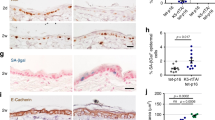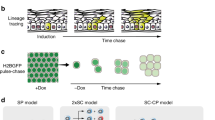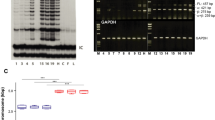Abstract
Tumour-promoting phorbol esters elicit a variety of molecular responses from cells in culture1–3. Phorbol esters are also active as promoters of neoplastic transformation in 10T1/2 mouse fibroblasts, previously initiated by polycyclic aromatic hydrocarbons4 or UV5 or X-ray irradiation6. As many in vivo studies of the tumour-promoting activity of phorbol esters have been carried out in mouse skin7, it seems desirable to use mouse epidermal cell lines to study the mechanism of tumour promotion in vitro. Mouse epidermal cell lines would be particularly useful if they responded to phorbol esters by progressing towards a neoplastic phenotype. We have previously reported the development of cell lines derived from primary mouse epidermal cultures after carcinogen or solvent exposure8. Some of these cell lines remained non-tumorigenic for many passages and failed to form colonies in soft agar (frequency less than 10−4)9. We next asked whether some of these non-tumorigenic cells might respond to tumour promoters like ‘initiated’ or ‘post-initiated’ cells in vivo by progressing towards a neoplastic state9,10. We report here the identification of three epidermal cell lines which respond to tumour-promoting but not to non-promoting phorbol esters by irreversibly acquiring capacity to grow in soft agar. As anchorage-independent growth characterises malignant cells derived from a variety of sources including mouse epidermis8,11, this response to phorbol esters may be analogous to a late stage of tumour promotion in vivo.
This is a preview of subscription content, access via your institution
Access options
Subscribe to this journal
Receive 51 print issues and online access
$199.00 per year
only $3.90 per issue
Buy this article
- Purchase on Springer Link
- Instant access to full article PDF
Prices may be subject to local taxes which are calculated during checkout
Similar content being viewed by others
References
Rovera, G., O'Brien Thomas, G. & Diamond, L. Proc. natn. Acad. Sci. U.S.A. 74, 2894–2898 (1977).
Yamasaki, H. et al. Proc. natn. Acad. Sci. U.S.A. 74, 3451–3455 (1977).
Blumberg, P. M., Driedger, P. E. & Rossow, P. W. Nature 264, 446–447 (1976).
Mondal, S., Brankow, D. W. & Heidelberger, C. Cancer Res. 36, 2254–2260 (1976).
Mondal, S. & Heidelberger, C. Nature 260, 710–711 (1976).
Kennedy, A. R., Mondal, S., Heidelberger, C. & Little, J. B. Cancer Res. 38, 439–443 (1978).
Boutwell, R. K. CRC Crit. Rev. Toxic., 419–443 (1974).
Colburn, N. H. et al. Cancer Res. 38, 624–634 (1978).
Colburn, N. H., Vorder Bruegge, W. F., Bates, J. & Yuspa, S. H. Carcinogenesis Vol. 2 (eds Slaga, T. J., Sivak, A. & Boutwell, R. K.) 257–271 (Raven, New York, 1978).
Colburn, N. H., Former, B. & Warren, L. Proc. Am. Ass. Cancer Res. 19, 65 (1978).
Shin, S., Freedman, V. H., Risser, R. & Pollack, R. Proc natn. Acad. Sci. U.S.A. 72, 4435–4437 (1975).
Yuspa, S. H. & Harris, C. C. Expl Cell Res. 86, 95–105 (1974).
Boutwell, R. K. Prog. exp. Tumour Res. 4, 207–250 (1964).
Rose, S. P., Stahn, R., Passovoy, D. S. & Hershman, H. Experientia 32, 913–914 (1976).
Todaro, G. T., De Larco, J. E. & Sporn, M. B. Nature 276, 272–274 (1978).
Baird, W. M. & Boutwell, R. K. Cancer Res. 31, 1074–1079 (1971).
Weinstein, I. B. & Wigler, M. Nature 370, 659–660 (1977).
Wigler, M. & Weinstein, I. B. Nature 259, 232–233 (1976).
O'Brien, T. G. Cancer Res. 36, 2644–2653 (1976).
O'Brien, T. G., Simsiman, R. C. & Boutwell, R. K. Cancer Res. 35, 1662–1670 (1975).
Yuspa, S. H. et al. Nature 262, 402–404 (1976).
Colburn, N. H. in Carcinogenesis Vol. 5 (ed. Slaga, T. J.) (Raven, New York, in the press).
Burns, F. J., Vanderlaan, M., Snyder, E. & Albert, R. E. in Carcinogenesis Vol. 2 (eds Slaga, T. J., Sivak, A. & Boutwell, R. K.) 91–96 (Raven, New York, 1978).
Author information
Authors and Affiliations
Rights and permissions
About this article
Cite this article
Colburn, N., Former, B., Nelson, K. et al. Tumour promoter induces anchorage independence irreversibly. Nature 281, 589–591 (1979). https://doi.org/10.1038/281589a0
Received:
Accepted:
Published:
Issue Date:
DOI: https://doi.org/10.1038/281589a0
This article is cited by
-
Synthesis and study of thioglycoside conjugates of 4-chloro-1,2-dithiol-3-one as potential cancer-preventive substances in vitro and in vivo
Russian Chemical Bulletin (2022)
-
Synthesis and studies of acetylthioglycoside conjugates of 4-chloro-1,2-dithiole-3-thione as potential antitumor agents
Russian Chemical Bulletin (2021)
-
In vitro anticancer activity of the laminarans from Far Eastern brown seaweeds and their sulfated derivatives
Journal of Applied Phycology (2017)
-
Extracellular signal-regulated kinases 1/2 and Akt contribute to triclosan-stimulated proliferation of JB6 Cl 41-5a cells
Archives of Toxicology (2015)
-
Oxidative Stress and Dermal Toxicity of Iron Oxide Nanoparticles In Vitro
Cell Biochemistry and Biophysics (2013)
Comments
By submitting a comment you agree to abide by our Terms and Community Guidelines. If you find something abusive or that does not comply with our terms or guidelines please flag it as inappropriate.



